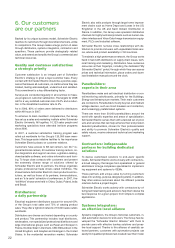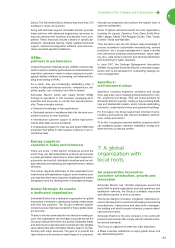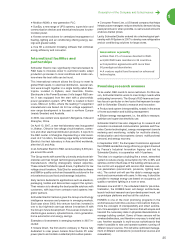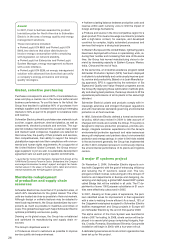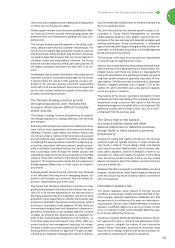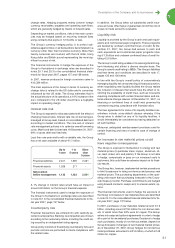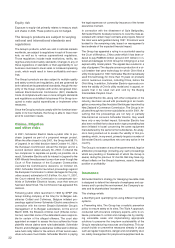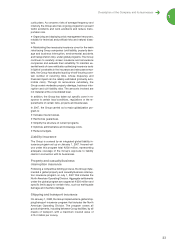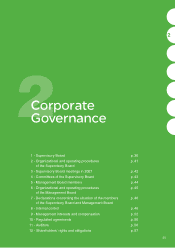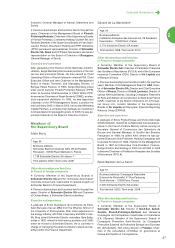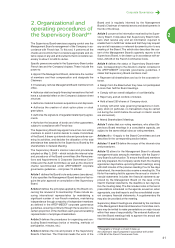APC 2007 Annual Report Download - page 33
Download and view the complete annual report
Please find page 33 of the 2007 APC annual report below. You can navigate through the pages in the report by either clicking on the pages listed below, or by using the keyword search tool below to find specific information within the annual report.
31
Description of the Company and its businesses
1
A 1% change in interest rates would have an impact of
around 8 million on the Group’s financial expense.
The financial instruments used to hedge the exposure of
the Group to fluctuations in exchange rates are described
in note 20.1 to the consolidated financial statements for fis-
cal year 2007, page 137 below.
Counterparty risk
Financial transactions are entered into with carefully se-
lected counterparties. Banking counterparties are chosen
according to the customary criteria, including the credit rat-
ing issued by an independent rating agency.
Group policy consists of diversifying counterparty risks and
periodic controls are performed to check compliance with
the related rules.
change rates. Hedging programs mainly concern foreign
currency receivables, payables and operating cash flows,
which are generally hedged by means of forward sales.
Depending on market conditions, risks in the main curren-
cies may be hedged based on recurring forecast flows
using contracts that expire in 12 months or less.
The Group’s currency hedging policy is to protect sub-
sidiaries against risks on all transactions denominated in a
currency other than their functional currency. More than
twenty currencies are involved, with the US dollar, Hong
Kong dollar and British pound representing the most sig-
nificant sources of risk.
The financial instruments to hedge the exposure of the
Group to fluctuations in exchange rates are described in
notes 20.1 and 20.3 to the consolidated financial state-
ments for fiscal year 2007, pages 137 and 138 below.
In 2007, revenue produced in foreign currencies came to
12,334 million.
The main exposure of the Group in terms of currency ex-
change risks is related to the US dollar and to currencies
influenced by the US dollar. The Group estimates that in
the actual structure of its operations, a 10% increase of the
euro compared to the US dollar would have a negligible
impact on operating margin
Interest rate risk
The Group is exposed to risks associated with the effect of
changing interest rates. Interest rate risk on borrowings is
managed at Group level, based on consolidated debt and
according to market conditions. The core aim of interest
rate management policies is to optimize overall borrowing
costs. Most bond debt is fixed rate. At December 31, 2007,
66% of gross debt was fixed rate.
Less than one year and/or with a variable rate, the Group
has a net cash available of about 1.1 billion.
Up to 1 to More
1 year 5 years than
5 years
Financial liabilities 2,401 1,695 2,091
Financial assets 1,269 271 -
Net position
before management 1,132 1,423 2,091
In addition, the Group takes out substantial credit insur-
ance and uses other types of guarantees to limit the risk of
losses on trade accounts receivable.
Liquidity risk
Liquidity is provided by the Group's cash and cash equiv-
alents and commercial paper programs. These programs
are backed by undrawn confirmed lines of credit. At De-
cember 31, 2007, the Group had access to cash and
cash equivalents and commercial paper programs total-
ing 1.3 billion and undrawn confirmed lines of credit to-
taling 2.5 billion.
The Group’s credit rating enables it to raise significant long-
term financing and attract a diverse investor base. The
Group’s current credit rating is BBB+. The Group’s liabilities
and their terms and conditions are described in note 17,
pages 135 and 136 below.
In line with the Group’s overall policy of conservatively
managing liquidity risk and protecting its financial position,
when negotiating new liquidity facilities the Group resists
the inclusion of clauses that would have the effect of re-
stricting the availability of credit lines, such as covenants
requiring compliance with certain financial ratios and ma-
terial adverse change clauses. At December 31, 2007, no
financing or confirmed lines of credit was governed by
covenants requiring compliance with financial ratios.
The loan agreements for some of its liquidity facilities nev-
ertheless include cross-default clauses whereby if the
Group were to default on any of its liquidity facilities, it
would immediately be considered as having defaulted on
all such facilities.
Moreover, anticipated reimbursement provisions exist for
certain financing and lines of credit in case of change of
control.
An increase in raw material prices could
have negative consequences
The Group is exposed to fluctuations in energy and raw
material prices (in particular steel, copper, aluminum, sil-
ver, lead, nickel, zinc and plastic). If the Group is not able
to hedge, compensate or pass on our increased costs to
customers, this could have an adverse impact on its finan-
cial results.
The Group has, however, implemented certain procedures
to limit its exposure to rising non-ferrous and precious raw
material prices. The purchasing departments of the oper-
ating units report their purchasing forecasts to the Corpo-
rate Treasury Center. Purchase commitments are hedged
using forward contracts, swaps and, to a lesser extent, op-
tions.
The financial instruments used to hedge the exposure of
the Group to increases in raw material prices are described
in note 20.1 to the consolidated financial statements for fis-
cal year 2007, page 137 below.
In 2007, purchases of raw materials totaled around 1.3
billion, including around 750 million for non-ferrous met-
als, of which more than 62% were for copper. The Group
enters into swap and options agreements in order to hedge
all or part of its raw material purchases. Decisions to hedge
such purchases, mostly of non-ferrous metals, depend on
Group forecasts of changes of raw material market prices.
As of December 31, 2007, Group hedges for non-ferrous
metal purchases amounted to 214 million, of which 148
million for copper.



